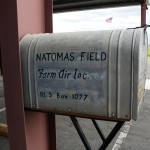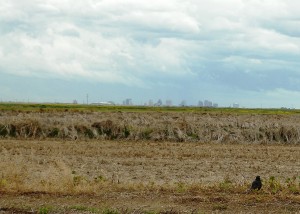» posted on Wednesday, April 11th, 2012 by Linda Lou Burton
The Serendipity of Rice
Linda Burton posting from Sacramento, California — “You can tell by the scars on my knuckles that I grew up on a rice farm,” said Bill. “My father started farming rice in the 50’s and continued more than forty years. I know rice.” Indeed he does, and he likes to talk about rice, too. William Huffman is now Vice-president of Communications for the Farmer’s Rice Cooperative in Sacramento, and can tell you what you want to know. “Arkansas plants more acres that California does,” he continued, “but we have a higher yield, because we have the perfect Mediterranean climate here.”
Bill directed me to the Natomas Basin, just north of town, to view a farm. I had in mind an image of terraced rows of rice on Asian mountainsides, but Bill dispelled that image fast. “We even use laser-beam equipment for precise flat farming now,” he explained, “because water is so important. And fortunately our clay soil holds on to every drop.”
 I drove to the airfield on Riego Road, where crop planes wait; spring rains have made the planting season late this year.
I drove to the airfield on Riego Road, where crop planes wait; spring rains have made the planting season late this year.  Inside, Rebecca showed me many maps of fields, pointing to each check (or row) and irrigation ditch, the precious water carefully contained. “When it’s time to plant,” she said, “a farmer calls his order in, tells us what he wants and when; then we soak the seeds; 24 hours is best.
Inside, Rebecca showed me many maps of fields, pointing to each check (or row) and irrigation ditch, the precious water carefully contained. “When it’s time to plant,” she said, “a farmer calls his order in, tells us what he wants and when; then we soak the seeds; 24 hours is best.  Seeds are hauled by truck to the hangar, loaded into the hopper, and released into the plane for planting. We used to have someone directing the pilots by standing at the end of each row with a white flag,” she said, “now we use GPS. It’s fast.”
Seeds are hauled by truck to the hangar, loaded into the hopper, and released into the plane for planting. We used to have someone directing the pilots by standing at the end of each row with a white flag,” she said, “now we use GPS. It’s fast.”
 Though everything is old-crop stubble now, I can visualize the summer fields of green. And of course I wondered how, and why, rice farming ever started here. The Farmer’s Rice Cooperative website answered that. Although commercial production didn’t begin until 1912, rice farming began in gold-rush days. The Chinese immigrated to California like millions of others – hoping to strike it rich. Most of the people who came brought pick and shovel, but not food; dramatic food shortages resulted. The Chinese were a huge part of the labor force, often doing the most dangerous and difficult work, and rice was a staple in their diet. Keeping them fed was important, but the price of rice kept going up. Out of desperation, farmers who came to seek gold soon saw that riches might be found in doing what they did back home—growing crops. The farmers were right.
Though everything is old-crop stubble now, I can visualize the summer fields of green. And of course I wondered how, and why, rice farming ever started here. The Farmer’s Rice Cooperative website answered that. Although commercial production didn’t begin until 1912, rice farming began in gold-rush days. The Chinese immigrated to California like millions of others – hoping to strike it rich. Most of the people who came brought pick and shovel, but not food; dramatic food shortages resulted. The Chinese were a huge part of the labor force, often doing the most dangerous and difficult work, and rice was a staple in their diet. Keeping them fed was important, but the price of rice kept going up. Out of desperation, farmers who came to seek gold soon saw that riches might be found in doing what they did back home—growing crops. The farmers were right.
Over 95 percent of the 2 million tons of rice grown annually in California now is planted and harvested within 100 miles of Sacramento. California grows the “sticky” rice, short and medium-grain japonica, favored by Asian, Middle Eastern, and Mediterranean markets. Although most of that rice is consumed domestically (for table rice, or for making sushi, beer, and pet food), it also is exported to Canada, Hong Kong, Jordan, Kuwait, Lebanon, Liberia, Singapore, Sweden, Taiwan, Turkey, and the United Kingdom.
Farmer’s Rice Cooperative http://www.farmersrice.com/index.htm
Farm Air Flying Service, 4425 W Riego Road, Sacramento, California 95837
